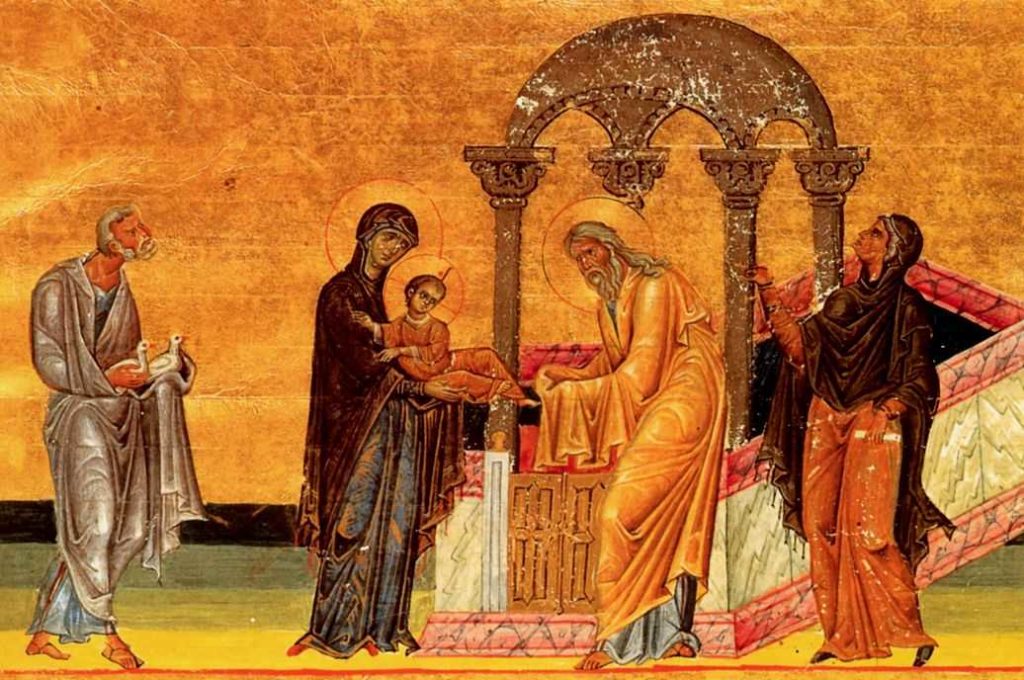
Very few people in our nation and in our state attend church on a regular basis. I think probably all of us here this morning are aware of this fact. I recall reading some time back that only one out of five Virginians attends church on a regular basis. Believing Christians themselves are often not regular in worshiping God every Sunday in his church. And, alas, many Anglicans and Anglican Catholics are no exception to this unfortunate trend.
In our Gospel reading for today, we hear about five people who were incredibly faithful in their religious duties. These five individuals, all members of the Old Testament Church, were Jesus, Mary, Joseph, Simeon, and Anna. Their piety and faithfulness to God, as recounted in the Gospel, was remarkable.
Mary and Joseph, along with their 40-day-old firstborn son, Jesus, made the long journey from Nazareth to Jerusalem. They did so as faithful Jews in accordance with the Law. As stipulated in Leviticus 12, when a woman gave birth to a male child, she was considered unclean for seven days. On the eighth day, the child was to be circumcised. For the next 33 days she couldn’t touch any consecrated thing nor enter the sanctuary. It is only then, after these 40 days, that her purification period was completed.
She was then required to bring to the Temple a lamb for burnt offering and a young pigeon or turtledove for a sin offering. If she couldn’t afford a lamb, she could offer two turtledoves or two young pigeons. Joseph and Mary were not wealthy, and so Mary offered the turtledoves or pigeons.
Jesus, you see, did not come from a wealthy family. In fact, his family was poor. They were not destitute, since Joseph had a trade as a carpenter. But the family was indeed of humble circumstances. Perhaps this helps to explain, at least from the human aspect, why Jesus was always so close and sympathetic to poor people.
At any rate, the Holy Family in the Temple at Jerusalem are confronted by two senior citizens. The first was Simeon. He is described as a righteous and devout man, who was looking for the consolation of Israel; “and the Holy Spirit was upon him.” Very few men are described as righteous or devout in the Bible. Simeon was clearly a very holy man, a saint of the Old Testament.
Luke tells us as well that the Holy Spirit had revealed to Simeon that he would not die before seeing the Messiah. And it was was the Holy Spirit that led and directed Simeon into the Temple that day. Amazingly, when he saw the Christ child, Simeon recognized who this was. He took the child into his arms and blessed God using the words of the Canticle we call the Nunc dimittis. “Lord, now lettest now thy servant depart in peace, according to thy word. For mine eyes have seen thy salvation, which thou hast prepared before the face of all people. To be a light of revelation to the Gentiles, and the glory of thy people Israel.” We sing or recite these words of Simeon every day at Evening Prayer.
Luke relates that Mary and Joseph are astonished to hear these words of Simeon. Because these words describe Jesus as the Messiah, the Savior, who will bring the light of God’s revelation to the world. And not only to God’s chosen people of Israel, but even to the Gentiles.
Simeon then addressed further words to Mary. “Behold, this child is appointed for the fall and rise of many in Israel, and for a sign to be opposed—and a sword will pierce even your own soul—to the end that thoughts from many hearts may be revealed.” These words were no doubt highly perplexing to Mary. What could they possibly mean? We know, as she did not at the time, that these words were prophetic of Jesus’ ministry. His teaching and ministry would cause conflict and opposition, and eventually lead to his crucifixion. This would indeed bring great pain and sorrow to Mary.
Finally, Luke tells us that an aged and devout woman, a prophetess named Anna, also came into the Temple at this time. She was a widow of many decades and spent most of her time in the Temple fasting and praying. An incredible example of amazing, extended, lifelong devotion and piety. And like Simeon, Anna recognized who Jesus was. She gave thanks to God and spoke about Jesus ”to all those who were looking for the redemption of Jerusalem.”
Our Gospel reading today is a continuation of the Christmas story, or what scholars call the infancy narratives. These are the birth of Jesus, the circumcision of Jesus, and the presentation of Jesus in the Temple. In each one of these accounts, Luke shows who Jesus is: the Messiah/King and Savior of the world.
In today’s Gospel reading, Simeon and Anna, two pious senior citizens, one male and the other female, proclaim and give witness to Jesus. He is the Messiah, the consolation of Israel, the light of the world, the glory of Israel, the salvation of mankind, and a sign of judgment and decision.
We see as well the universality of Jesus as Savior. He is for all people: Jews and Gentiles, men and women, rich and poor, young and old.
Beloved in Christ, let’s you and I take comfort and courage from the five people who were incredibly faithful in our Gospel reading today. Let’s give thanks for Jesus, our Savior and our King, our Redeemer and our Advocate. And let’s be willing, like Anna, to speak about Jesus to those whom God puts in our way and who are, whether they know it or not, looking for the redemption of Jerusalem.
